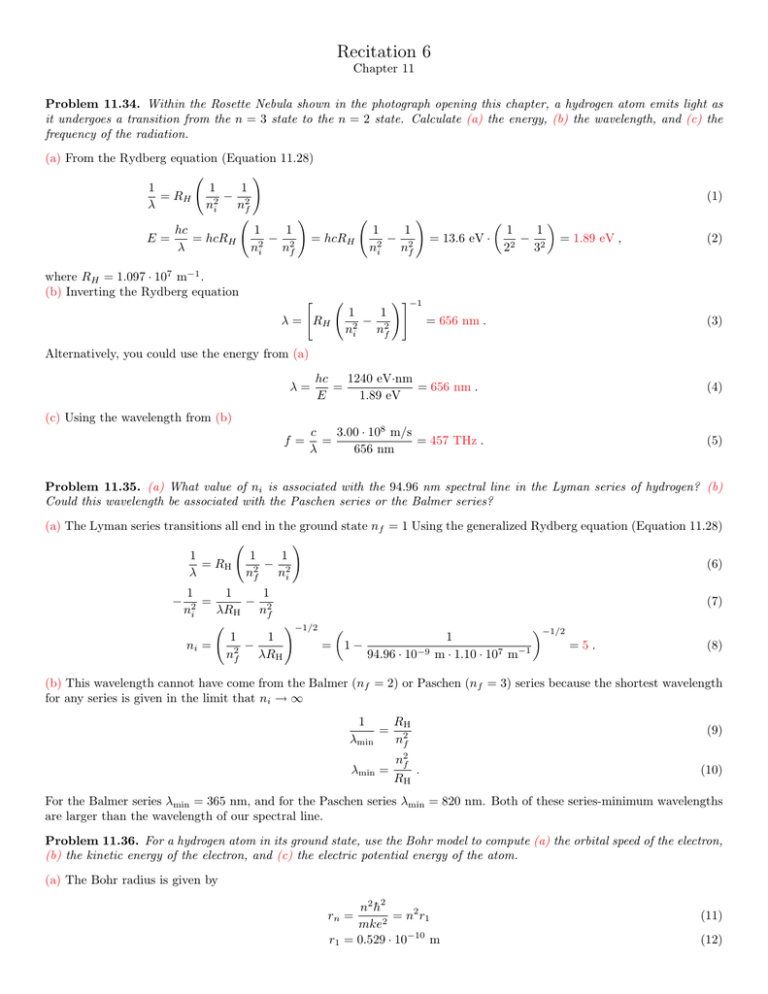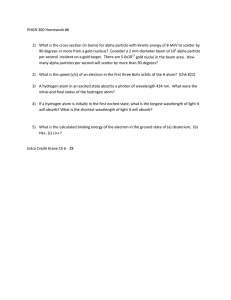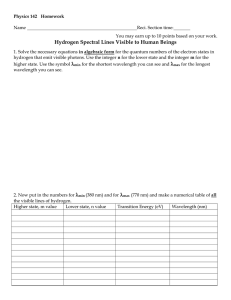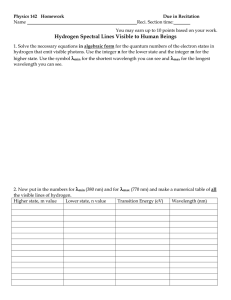Recitation 6
advertisement

Recitation 6 Chapter 11 Problem 11.34. Within the Rosette Nebula shown in the photograph opening this chapter, a hydrogen atom emits light as it undergoes a transition from the n = 3 state to the n = 2 state. Calculate (a) the energy, (b) the wavelength, and (c) the frequency of the radiation. (a) From the Rydberg equation (Equation 11.28) ! 1 1 1 − 2 = RH λ n2i nf ! 1 hc 1 − 2 = hcRH E= = hcRH λ n2i nf (1) 1 1 − 2 2 ni nf ! = 13.6 eV · 1 1 − 2 2 2 3 = 1.89 eV , (2) where RH = 1.097 · 107 m−1 . (b) Inverting the Rydberg equation " 1 1 − 2 n2i nf λ = RH !#−1 = 656 nm . (3) Alternatively, you could use the energy from (a) hc 1240 eV·nm = = 656 nm . E 1.89 eV (4) 3.00 · 108 m/s c = = 457 THz . λ 656 nm (5) λ= (c) Using the wavelength from (b) f= Problem 11.35. (a) What value of ni is associated with the 94.96 nm spectral line in the Lyman series of hydrogen? (b) Could this wavelength be associated with the Paschen series or the Balmer series? (a) The Lyman series transitions all end in the ground state nf = 1 Using the generalized Rydberg equation (Equation 11.28) ! 1 1 1 = RH (6) − 2 λ n2f ni − 1 1 1 = − 2 2 ni λRH nf ni = 1 1 − 2 nf λRH (7) !−1/2 = 1− 94.96 · 10−9 1 m · 1.10 · 107 m−1 −1/2 =5. (8) (b) This wavelength cannot have come from the Balmer (nf = 2) or Paschen (nf = 3) series because the shortest wavelength for any series is given in the limit that ni → ∞ 1 λmin = λmin = RH n2f n2f . RH (9) (10) For the Balmer series λmin = 365 nm, and for the Paschen series λmin = 820 nm. Both of these series-minimum wavelengths are larger than the wavelength of our spectral line. Problem 11.36. For a hydrogen atom in its ground state, use the Bohr model to compute (a) the orbital speed of the electron, (b) the kinetic energy of the electron, and (c) the electric potential energy of the atom. (a) The Bohr radius is given by n2 h̄2 = n2 r1 mke2 r1 = 0.529 · 10−10 m rn = (11) (12) where h̄ = h/(2π) = 1.055 · 10−34 J·s and k = 9.00 · 109 Nm2 /C2 . So the velocity is nh̄ mrn h̄ v1 = = 2.19 Mm/s . mr1 vn = (13) (14) (15) (b) The kinetic energy is then K= 1 mv 2 = 13.6 eV . 2 (16) e2 = −27.2 eV . r (17) (c) The electric potential energy is U = −k Problem 11.37. Four possible transitions for a hydrogen atom are as follows: (i) (iii) ni = 2; nf = 5 ni = 7; nf = 4 (ii) (iv) ni = 5; nf = 3 ni = 4; nf = 7 (a) In which transition is light of the shortest wavelength emitted? (b) In which transition does the atom gain the most energy? (c) In which transition(s) does the atom lose energy? (a) Looking at the sized of the changes in n, we have (i) (iii) ∆n = 3 ∆n = −3 (ii) (iv) ∆n = −2 ∆n = 3 We know we want to release energy, so we need ∆n < 0 (relaxing from a more excited state). That leaves (ii) and (iii). We have to crunch some numbers for this, since each case has a point in its favor: (iii) jumps more levels, but (ii) is closer in, where the levels are further apart. 1 1 − = −71 · 10−3 · A (18) Eii = A 52 32 1 1 Eiii = A − = −42 · 10−3 · A , (19) 72 42 so (ii) releases the most energy. Note that A = hcRH = 13.6 eV, but it’s actual value doesn’t matter because it is a constant value for hydrogen. (b) Now we need to compare (i) and (iv), but this is easier, since they both increase by three levels, but (i) starts closer in (where the levels are further apart). Therefore, (i) will gain the most energy. (c) The atom loses energy in (ii) and (iii) as mentioned in (a). Problem 11.38. How much energy is required to ionize hydrogen (a) when it is in the ground state and (b) when it is in the state for which n = 3? Ionization can be considered to be the state where nf = ∞. Using the Rydberg equation and E = hc/λ we have Eabsorbed = hcRH 1 n2i − ni 1 n2f (a) 1 (b) 3 13.6 eV 1.51 eV Problem 11.41. Two hydrogen atoms collide head-on and end up with zero kinetic energy. Each atom then emits light with a wavelength of 121.6 nm (n = 2 to n = 1 transition). At what speed where the atoms moving before the collision? Ending up with zero kinetic energy after the collision means the atoms must have zero velocity and momentum after the collision as well. Conserving momentum, we see that having zero momentum after the collision, means their momenta before the collision must have been equal and opposite. Because both atoms are hydrogens, their masses are the same, so their velocities must have also been equal and opposite. Thus, their initial kinetic energies must have been equal. Conserving energy 1 hc Ei = 2 · mvi2 = mvi2 = Ef = 2 · 2 λ s r 2hc 2 · 6.63 · 10−34 J·s · 3.00 · 108 m/s vi = = = 44.3 km/s . λm 121.6 · 10−9 m · 1.67 · 10−27 kg (20) (21) Note that the mass of a hydrogen atom is the sum of the masses of a proton and electron, but me mp , which is why mH ≈ mp = 1.67 · 10−27 kg.



